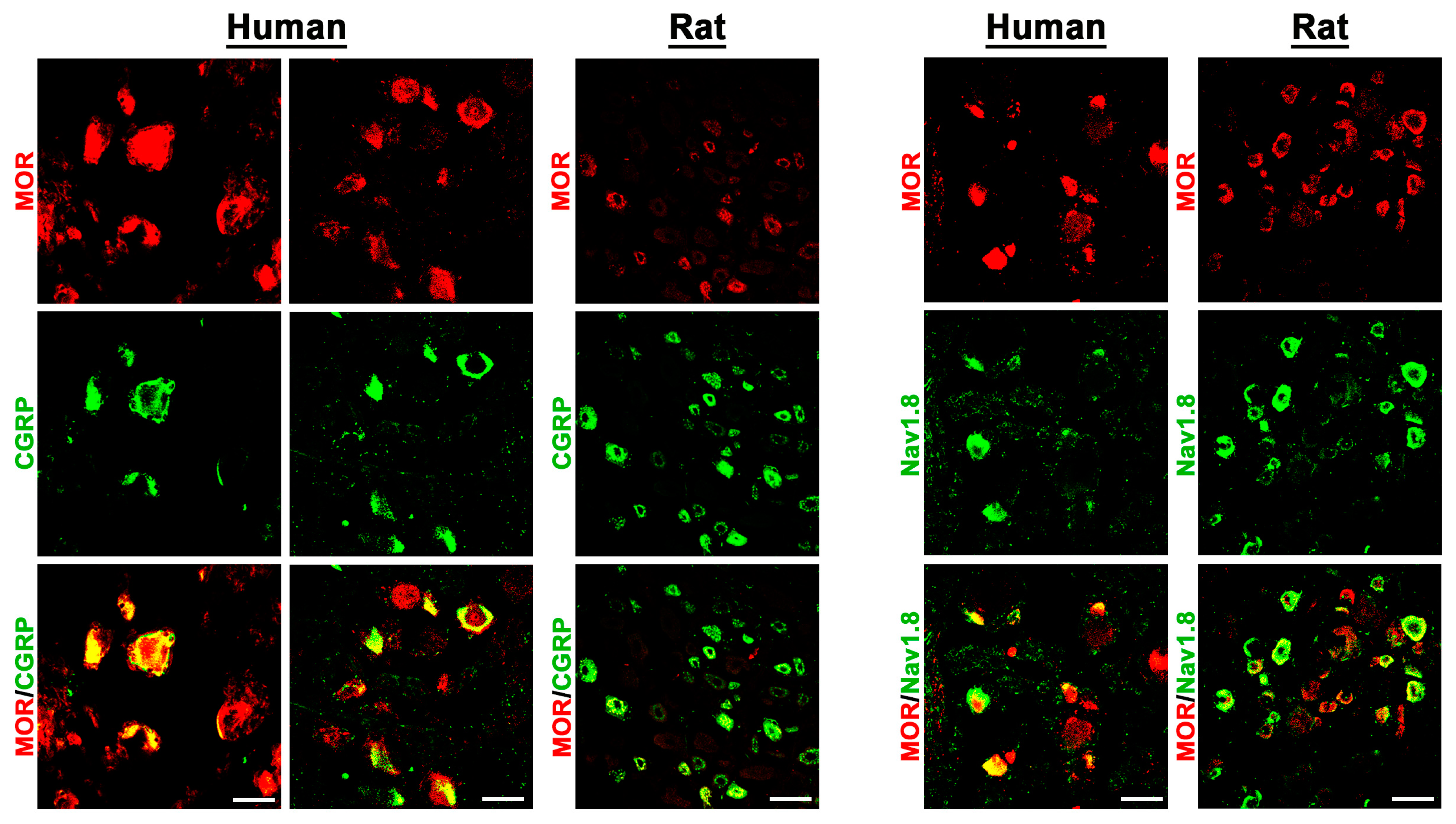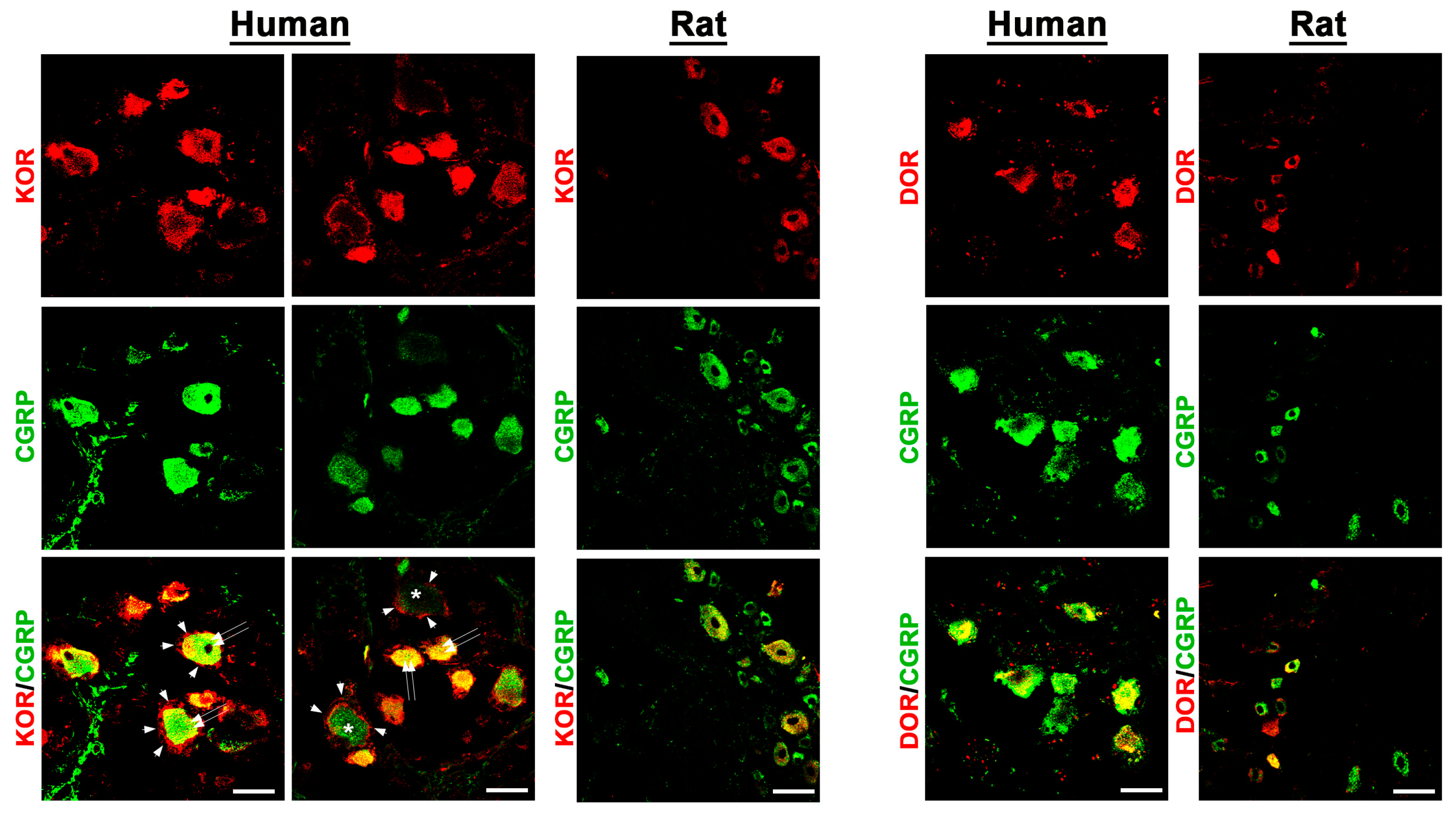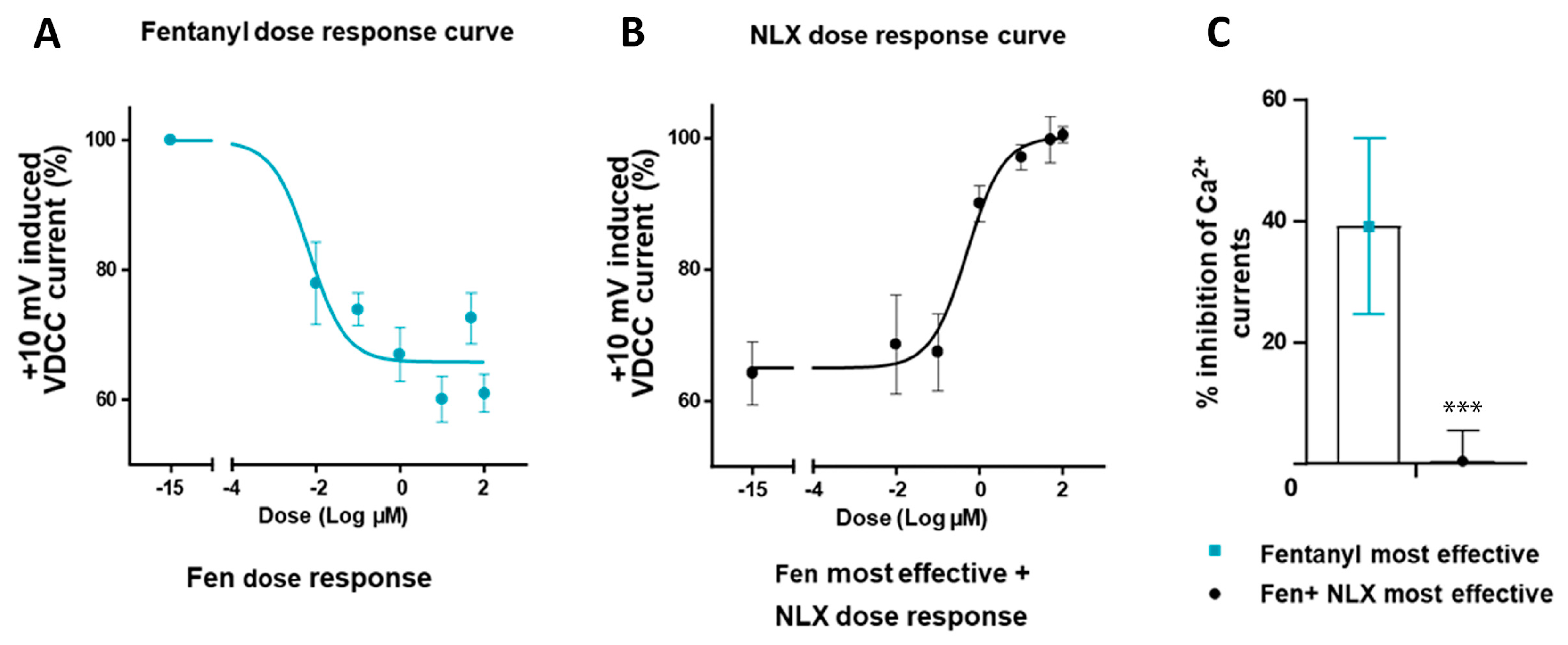The Identification of Opioid Receptors and Peptide Precursors in Human DRG Neurons Expressing Pain-Signaling Molecules Confirms Their Potential as Analgesic Targets
Abstract
1. Introduction
2. Materials and Methods
2.1. Collection of Human and Rat DRG Tissue Samples
2.2. Quantitative qRT-PCR in Human and Rat DRG Neurons
2.3. Immunohistochemistry in Human and Rat DRG
2.4. Electrophysiological Experiments of Opioids in Rat DRG
2.5. Statistics
3. Results
3.1. Identification of Key Pain-Signaling Molecules in CGRP-IR Sensory Neurons of Human Compared to Rat DRG Neurons
3.2. Opioid Receptor Detection of MOR, DOR, and KOR in CGRP-IR Sensory Neurons of Human Compared to Rat DRG Neurons
3.3. Identification of the Opioid Peptide Precursors POMC, PENK, and PDYN in Human Compared to Rat DRG Neurons
3.4. Predominant mRNA Expression of MOR over DOR and KOR, as Well as of the Endogenous Opioid Peptide Precursors, in Human Compared to Rat DRG Neurons
3.5. Expression of Pain-Relevant mRNA Transcripts in Relation to MOR Transcripts in Human and Rat DRG
3.6. Inhibition of VDCC Activity by the MOR Selective Agonist Fentanyl in Rat DRG Neurons
4. Discussion
5. Conclusions
Supplementary Materials
Author Contributions
Funding
Institutional Review Board Statement
Informed Consent Statement
Data Availability Statement
Acknowledgments
Conflicts of Interest
References
- Khalefa, B.I.; Shaqura, M.; Al-Khrasani, M.; Furst, S.; Mousa, S.A.; Schafer, M. Relative contributions of peripheral versus supraspinal or spinal opioid receptors to the antinociception of systemic opioids. Eur. J. Pain 2012, 16, 690–705. [Google Scholar] [CrossRef] [PubMed]
- Macintyre, P.E.; Quinlan, J.; Levy, N.; Lobo, D.N. Current Issues in the Use of Opioids for the Management of Postoperative Pain: A Review. JAMA Surg. 2022, 157, 158–166. [Google Scholar] [CrossRef] [PubMed]
- Fairbanks, C.A.; Peterson, C.D. The opioid receptor: Emergence through millennia of pharmaceutical sciences. Front. Pain Res. 2023, 4, 960389. [Google Scholar] [CrossRef]
- Stein, C.; Schäfer, M.; Machelska, H. Attacking pain at its source: New perspectives on opioids. Nat. Med. 2003, 9, 1003–1008. [Google Scholar] [CrossRef]
- Stein, C. Opioid analgesia: Recent developments. Curr. Opin. Support. Palliat. Care 2020, 14, 112–117. [Google Scholar] [CrossRef] [PubMed]
- Stein, C.; Comisel, K.; Haimerl, E.; Yassouridis, A.; Lehrberger, K.; Herz, A.; Peter, K. Analgesic effect of intraarticular morphine after arthroscopic knee surgery. N. Engl. J. Med. 1991, 325, 1123–1126. [Google Scholar] [CrossRef]
- Zou, Z.; An, M.M.; Xie, Q.; Chen, X.Y.; Zhang, H.; Liu, G.J.; Shi, X.Y. Single dose intra-articular morphine for pain control after knee arthroscopy. Cochrane Database Syst. Rev. 2016, 2016, Cd008918. [Google Scholar] [CrossRef]
- Rosseland, L.A. No evidence for analgesic effect of intra-articular morphine after knee arthroscopy: A qualitative systematic review. Reg. Anesth. Pain Med. 2005, 30, 83–98. [Google Scholar] [CrossRef]
- Kalso, E.; Tramèr, M.R.; Carroll, D.; McQuay, H.J.; Moore, R.A. Pain relief from intra-articular morphine after knee surgery: A qualitative systematic review. Pain 1997, 71, 127–134. [Google Scholar] [CrossRef]
- Santino, F.; Gentilucci, L. Design of κ-Opioid Receptor Agonists for the Development of Potential Treatments of Pain with Reduced Side Effects. Molecules 2023, 28, 346. [Google Scholar] [CrossRef]
- Martínez, V.; Abalo, R. Peripherally acting opioid analgesics and peripherally-induced analgesia. Behav. Pharmacol. 2020, 31, 136–158. [Google Scholar] [CrossRef]
- Vanderah, T.W. Delta and kappa opioid receptors as suitable drug targets for pain. Clin. J. Pain 2010, 26 (Suppl. 10), S10–S15. [Google Scholar] [CrossRef]
- Barber, A.; Gottschlich, R. Opioid agonists and antagonists: An evaluation of their peripheral actions in inflammation. Med. Res. Rev. 1992, 12, 525–562. [Google Scholar] [CrossRef]
- Bangash, M.A.; Cubuk, C.; Iseppon, F.; Haroun, R.; Garcia, C.; Luiz, A.P.; Arcangeletti, M.; Gossage, S.J.; Santana-Varela, S.; Cox, J.J.; et al. Analgesic targets identified in mouse sensory neuron somata and terminal pain translatomes. Cell Rep. 2024, 43, 114614. [Google Scholar] [CrossRef] [PubMed]
- Bhuiyan, S.A.; Xu, M.; Yang, L.; Semizoglou, E.; Bhatia, P.; Pantaleo, K.I.; Tochitsky, I.; Jain, A.; Erdogan, B.; Blair, S.; et al. Harmonized cross-species cell atlases of trigeminal and dorsal root ganglia. Sci. Adv. 2024, 10, eadj9173. [Google Scholar] [CrossRef] [PubMed]
- Quirion, B.; Beaulieu, C.; Côté, L.; Parent, J.L.; Gendron, L. Distribution of delta and mu opioid receptor mRNA in rodent dorsal root ganglia neurons. Eur. J. Neurosci. 2022, 56, 4031–4044. [Google Scholar] [CrossRef] [PubMed]
- Shiers, S.; Klein, R.M.; Price, T.J. Quantitative differences in neuronal subpopulations between mouse and human dorsal root ganglia demonstrated with RNAscope in situ hybridization. Pain 2020, 161, 2410–2424. [Google Scholar] [CrossRef]
- Tavares-Ferreira, D.; Shiers, S.; Ray, P.R.; Wangzhou, A.; Jeevakumar, V.; Sankaranarayanan, I.; Cervantes, A.M.; Reese, J.C.; Chamessian, A.; Copits, B.A.; et al. Spatial transcriptomics of dorsal root ganglia identifies molecular signatures of human nociceptors. Sci. Transl. Med. 2022, 14, eabj8186. [Google Scholar] [CrossRef]
- Ray, P.; Torck, A.; Quigley, L.; Wangzhou, A.; Neiman, M.; Rao, C.; Lam, T.; Kim, J.Y.; Kim, T.H.; Zhang, M.Q.; et al. Comparative transcriptome profiling of the human and mouse dorsal root ganglia: An RNA-seq-based resource for pain and sensory neuroscience research. Pain 2018, 159, 1325–1345. [Google Scholar] [CrossRef]
- Moy, J.K.; Hartung, J.E.; Duque, M.G.; Friedman, R.; Nagarajan, V.; Loeza-Alcocer, E.; Koerber, H.R.; Christoph, T.; Schröder, W.; Gold, M.S. Distribution of functional opioid receptors in human dorsal root ganglion neurons. Pain 2020, 161, 1636–1649. [Google Scholar] [CrossRef]
- Staedtler, E.S.; Sapio, M.R.; King, D.M.; Maric, D.; Ghetti, A.; Mannes, A.J.; Iadarola, M.J. The μ-opioid receptor differentiates two distinct human nociceptive populations relevant to clinical pain. Cell Rep. Med. 2024, 5, 101788. [Google Scholar] [CrossRef] [PubMed]
- Snyder, L.M.; Chiang, M.C.; Loeza-Alcocer, E.; Omori, Y.; Hachisuka, J.; Sheahan, T.D.; Gale, J.R.; Adelman, P.C.; Sypek, E.I.; Fulton, S.A.; et al. Kappa Opioid Receptor Distribution and Function in Primary Afferents. Neuron 2018, 99, 1274–1288.e1276. [Google Scholar] [CrossRef]
- Tafelski, S.; Wandrey, J.D.; Shaqura, M.; Hong, X.; Beyer, A.; Schäfer, M.; Mousa, S.A. Translation of Experimental Findings from Animal to Human Biology: Identification of Neuronal Mineralocorticoid and Glucocorticoid Receptors in a Sectioned Main Nerve Trunk of the Leg. Cells 2023, 12, 1785. [Google Scholar] [CrossRef]
- Livak, K.J.; Schmittgen, T.D. Analysis of relative gene expression data using real-time quantitative PCR and the 2(-Delta Delta C(T)) Method. Methods 2001, 25, 402–408. [Google Scholar] [CrossRef] [PubMed]
- Mousa, S.A.; Shaqura, M.; Schaper, J.; Huang, W.; Treskatsch, S.; Habazettl, H.; Abdul-Khaliq, H.; Schafer, M. Identification of mu- and kappa-opioid receptors as potential targets to regulate parasympathetic, sympathetic, and sensory neurons within rat intracardiac ganglia. J. Comp. Neurol. 2010, 518, 3836–3847. [Google Scholar] [CrossRef]
- Mousa, S.A.; Shaqura, M.; Schäper, J.; Treskatsch, S.; Habazettl, H.; Schäfer, M.; Abdul-Khaliq, H. Developmental expression of δ-opioid receptors during maturation of the parasympathetic, sympathetic, and sensory innervations of the neonatal heart: Early targets for opioid regulation of autonomic control. J. Comp. Neurol. 2011, 519, 957–971. [Google Scholar] [CrossRef] [PubMed]
- Riedl, M.S.; Schnell, S.A.; Overland, A.C.; Chabot-Doré, A.J.; Taylor, A.M.; Ribeiro-da-Silva, A.; Elde, R.P.; Wilcox, G.L.; Stone, L.S. Coexpression of alpha 2A-adrenergic and delta-opioid receptors in substance P-containing terminals in rat dorsal horn. J. Comp. Neurol. 2009, 513, 385–398. [Google Scholar] [CrossRef]
- Schulz, S.; Schreff, M.; Koch, T.; Zimprich, A.; Gramsch, C.; Elde, R.; Höllt, V. Immunolocalization of two mu-opioid receptor isoforms (MOR1 and MOR1B) in the rat central nervous system. Neuroscience 1998, 82, 613–622. [Google Scholar] [CrossRef]
- Mansour, A.; Burke, S.; Pavlic, R.J.; Akil, H.; Watson, S.J. Immunohistochemical localization of the cloned kappa 1 receptor in the rat CNS and pituitary. Neuroscience 1996, 71, 671–690. [Google Scholar] [CrossRef]
- Krajnik, M.; Schäfer, M.; Sobański, P.; Kowalewski, J.; Bloch-Bogusławska, E.; Zylicz, Z.; Mousa, S.A. Local pulmonary opioid network in patients with lung cancer: A putative modulator of respiratory function. Pharmacol. Rep. 2010, 62, 139–149. [Google Scholar] [CrossRef]
- Mousa, S.A.; Straub, R.H.; Schäfer, M.; Stein, C. Beta-endorphin, Met-enkephalin and corresponding opioid receptors within synovium of patients with joint trauma, osteoarthritis and rheumatoid arthritis. Ann. Rheum. Dis. 2007, 66, 871–879. [Google Scholar] [CrossRef] [PubMed]
- Wang, F.; Knutson, K.; Alcaino, C.; Linden, D.R.; Gibbons, S.J.; Kashyap, P.; Grover, M.; Oeckler, R.; Gottlieb, P.A.; Li, H.J.; et al. Mechanosensitive ion channel Piezo2 is important for enterochromaffin cell response to mechanical forces. J. Physiol. 2017, 595, 79–91. [Google Scholar] [CrossRef]
- Walwyn, W.; Evans, C.J.; Hales, T.G. Beta-arrestin2 and c-Src regulate the constitutive activity and recycling of mu opioid receptors in dorsal root ganglion neurons. J. Neurosci. Off. J. Soc. Neurosci. 2007, 27, 5092–5104. [Google Scholar] [CrossRef]
- Endres-Becker, J.; Heppenstall, P.A.; Mousa, S.A.; Labuz, D.; Oksche, A.; Schäfer, M.; Stein, C.; Zöllner, C. Mu-opioid receptor activation modulates transient receptor potential vanilloid 1 (TRPV1) currents in sensory neurons in a model of inflammatory pain. Mol. Pharmacol. 2007, 71, 12–18. [Google Scholar] [CrossRef] [PubMed]
- Mousa, S.A.; Shaqura, M.; Al-Madol, M.; Tafelski, S.; Khalefa, B.I.; Shakibaei, M.; Schafer, M. Accessibility of axonal G protein coupled mu-opioid receptors requires conceptual changes of axonal membrane targeting for pain modulation. J. Control. Release Off. J. Control. Release Soc. 2017, 268, 352–363. [Google Scholar] [CrossRef] [PubMed]
- Barry, A.M.; Sondermann, J.R.; Lesnak, J.B.; Xian, F.; Franco-Enzástiga, Ú.; O’Brien, J.A.; Varela, D.G.; Schackmuth, M.K.; Shiers, S.; Price, T.J.; et al. Multi-omic integration with human DRG proteomics highlights TNFα signalling as a relevant sexually dimorphic pathway. bioRxiv 2024. [Google Scholar] [CrossRef]
- Ray, P.R.; Shiers, S.; Caruso, J.P.; Tavares-Ferreira, D.; Sankaranarayanan, I.; Uhelski, M.L.; Li, Y.; North, R.Y.; Tatsui, C.; Dussor, G.; et al. RNA profiling of human dorsal root ganglia reveals sex differences in mechanisms promoting neuropathic pain. Brain A J. Neurol. 2023, 146, 749–766. [Google Scholar] [CrossRef]
- North, R.Y.; Li, Y.; Ray, P.; Rhines, L.D.; Tatsui, C.E.; Rao, G.; Johansson, C.A.; Zhang, H.; Kim, Y.H.; Zhang, B.; et al. Electrophysiological and transcriptomic correlates of neuropathic pain in human dorsal root ganglion neurons. Brain A J. Neurol. 2019, 142, 1215–1226. [Google Scholar] [CrossRef]
- Doty, M.; Yun, S.; Wang, Y.; Hu, M.; Cassidy, M.; Hall, B.; Kulkarni, A.B. Integrative multiomic analyses of dorsal root ganglia in diabetic neuropathic pain using proteomics, phospho-proteomics, and metabolomics. Sci. Rep. 2022, 12, 17012. [Google Scholar] [CrossRef]
- Jung, M.; Dourado, M.; Maksymetz, J.; Jacobson, A.; Laufer, B.I.; Baca, M.; Foreman, O.; Hackos, D.H.; Riol-Blanco, L.; Kaminker, J.S. Cross-species transcriptomic atlas of dorsal root ganglia reveals species-specific programs for sensory function. Nat. Commun. 2023, 14, 366. [Google Scholar] [CrossRef]
- Nguyen, M.Q.; von Buchholtz, L.J.; Reker, A.N.; Ryba, N.J.; Davidson, S. Single-nucleus transcriptomic analysis of human dorsal root ganglion neurons. Elife 2021, 10, 71752. [Google Scholar] [CrossRef] [PubMed]
- Schwaid, A.G.; Krasowka-Zoladek, A.; Chi, A.; Cornella-Taracido, I. Comparison of the Rat and Human Dorsal Root Ganglion Proteome. Sci. Rep. 2018, 8, 13469. [Google Scholar] [CrossRef] [PubMed]
- Shaqura, M.; Khalefa, B.I.; Shakibaei, M.; Zöllner, C.; Al-Khrasani, M.; Fürst, S.; Schäfer, M.; Mousa, S.A. New insights into mechanisms of opioid inhibitory effects on capsaicin-induced TRPV1 activity during painful diabetic neuropathy. Neuropharmacology 2014, 85, 142–150. [Google Scholar] [CrossRef]
- Shaqura, M.; Li, L.; Mohamed, D.M.; Li, X.; Treskatsch, S.; Buhrmann, C.; Shakibaei, M.; Beyer, A.; Mousa, S.A.; Schäfer, M. Neuronal aldosterone elicits a distinct genomic response in pain signaling molecules contributing to inflammatory pain. J. Neuroinflammation 2020, 17, 183. [Google Scholar] [CrossRef]
- Schicho, R.; Florian, W.; Liebmann, I.; Holzer, P.; Lippe, I.T. Increased expression of TRPV1 receptor in dorsal root ganglia by acid insult of the rat gastric mucosa. Eur. J. Neurosci. 2004, 19, 1811–1818. [Google Scholar] [CrossRef]
- Ma, Q.P. Vanilloid receptor homologue, VRL1, is expressed by both A- and C-fiber sensory neurons. Neuroreport 2001, 12, 3693–3695. [Google Scholar] [CrossRef]
- Goswami, S.C.; Thierry-Mieg, D.; Thierry-Mieg, J.; Mishra, S.; Hoon, M.A.; Mannes, A.J.; Iadarola, M.J. Itch-associated peptides: RNA-Seq and bioinformatic analysis of natriuretic precursor peptide B and gastrin releasing peptide in dorsal root and trigeminal ganglia, and the spinal cord. Mol. Pain 2014, 10, 44. [Google Scholar] [CrossRef]
- Espadas-Álvarez, H.; Martínez-Rendón, J.; Larre, I.; Matamoros-Volante, A.; Romero-García, T.; Rosenbaum, T.; Rueda, A.; García-Villegas, R. TRPV4 activity regulates nuclear Ca(2+) and transcriptional functions of β-catenin in a renal epithelial cell model. J. Cell Physiol. 2021, 236, 3599–3614. [Google Scholar] [CrossRef] [PubMed]
- Akopian, A.N.; Souslova, V.; England, S.; Okuse, K.; Ogata, N.; Ure, J.; Smith, A.; Kerr, B.J.; McMahon, S.B.; Boyce, S.; et al. The tetrodotoxin-resistant sodium channel SNS has a specialized function in pain pathways. Nat. Neurosci. 1999, 2, 541–548. [Google Scholar] [CrossRef]
- Weibel, R.; Reiss, D.; Karchewski, L.; Gardon, O.; Matifas, A.; Filliol, D.; Becker, J.A.; Wood, J.N.; Kieffer, B.L.; Gaveriaux-Ruff, C. Mu opioid receptors on primary afferent nav1.8 neurons contribute to opiate-induced analgesia: Insight from conditional knockout mice. PLoS ONE 2013, 8, e74706. [Google Scholar] [CrossRef]
- Ceredig, R.A.; Pierre, F.; Doridot, S.; Alduntzin, U.; Hener, P.; Salvat, E.; Yalcin, I.; Gaveriaux-Ruff, C.; Barrot, M.; Massotte, D. Peripheral Delta Opioid Receptors Mediate Formoterol Anti-allodynic Effect in a Mouse Model of Neuropathic Pain. Front. Mol. Neurosci. 2019, 12, 324. [Google Scholar] [CrossRef] [PubMed]
- Hovhannisyan, A.H.; Son, H.; Mecklenburg, J.; Barba-Escobedo, P.A.; Tram, M.; Gomez, R.; Shannonhouse, J.; Zou, Y.; Weldon, K.; Ruparel, S.; et al. Pituitary hormones are specifically expressed in trigeminal sensory neurons and contribute to pain responses in the trigeminal system. Sci. Rep. 2021, 11, 17813. [Google Scholar] [CrossRef] [PubMed]
- Sapio, M.R.; Iadarola, M.J.; Loydpierson, A.J.; Kim, J.J.; Thierry-Mieg, D.; Thierry-Mieg, J.; Maric, D.; Mannes, A.J. Dynorphin and Enkephalin Opioid Peptides and Transcripts in Spinal Cord and Dorsal Root Ganglion During Peripheral Inflammatory Hyperalgesia and Allodynia. J. Pain Off. J. Am. Pain Soc. 2020, 21, 988–1004. [Google Scholar] [CrossRef]
- Roques, B.P. Contribution of Delta-Opioid Receptors to Pathophysiological Events Explored by Endogenous Enkephalins. Handb. Exp. Pharmacol. 2018, 247, 53–70. [Google Scholar] [CrossRef]
- Dubner, R.; Ruda, M.A. Activity-dependent neuronal plasticity following tissue injury and inflammation. Trends Neurosci. 1992, 15, 96–103. [Google Scholar] [CrossRef]
- Wang, H.; Wessendorf, M.W. Equal proportions of small and large DRG neurons express opioid receptor mRNAs. J. Comp. Neurol. 2001, 429, 590–600. [Google Scholar] [CrossRef]
- Bagley, E.E.; Ingram, S.L. Endogenous opioid peptides in the descending pain modulatory circuit. Neuropharmacology 2020, 173, 108131. [Google Scholar] [CrossRef] [PubMed]
- Ossipov, M.H.; Lai, J.; Malan, T.P., Jr.; Porreca, F. Spinal and supraspinal mechanisms of neuropathic pain. Ann. N. Y. Acad. Sci. 2000, 909, 12–24. [Google Scholar] [CrossRef]
- Celik, M.; Seitz, V.; Yergöz, F.; Dembla, S.; Blum, N.K.; Schulz, S.; Stein, C. Modulation of G-protein activation, calcium currents and opioid receptor phosphorylation by the pH-dependent antinociceptive agonist NFEPP. Front. Mol. Neurosci. 2023, 16, 1171855. [Google Scholar] [CrossRef]
- Womack, M.D.; McCleskey, E.W. Interaction of opioids and membrane potential to modulate Ca2+ channels in rat dorsal root ganglion neurons. J. Neurophysiol. 1995, 73, 1793–1798. [Google Scholar] [CrossRef]
- Joris, J.L.; Dubner, R.; Hargreaves, K.M. Opioid analgesia at peripheral sites: A target for opioids released during stress and inflammation? Anesth. Analg. 1987, 66, 1277–1281. [Google Scholar] [CrossRef] [PubMed]
- Stein, C.; Millan, M.J.; Shippenberg, T.S.; Peter, K.; Herz, A. Peripheral opioid receptors mediating antinociception in inflammation. Evidence for involvement of mu, delta and kappa receptors. J. Pharmacol. Exp. Ther. 1989, 248, 1269–1275. [Google Scholar] [CrossRef] [PubMed]
- Schmidhammer, H.; Al-Khrasani, M.; Fürst, S.; Spetea, M. Peripheralization Strategies Applied to Morphinans and Implications for Improved Treatment of Pain. Molecules 2023, 28, 4761. [Google Scholar] [CrossRef] [PubMed]
- Nielsen, B.N.; Henneberg, S.W.; Schmiegelow, K.; Friis, S.M.; Rømsing, J. Peripherally applied opioids for postoperative pain: Evidence of an analgesic effect? A systematic review and meta-analysis. Acta Anaesthesiol. Scand. 2015, 59, 830–845. [Google Scholar] [CrossRef]
- Spahn, V.; Del Vecchio, G.; Labuz, D.; Rodriguez-Gaztelumendi, A.; Massaly, N.; Temp, J.; Durmaz, V.; Sabri, P.; Reidelbach, M.; Machelska, H.; et al. A nontoxic pain killer designed by modeling of pathological receptor conformations. Science 2017, 355, 966–969. [Google Scholar] [CrossRef]








| Gen | Human_DRG | Rat_DRG |
|---|---|---|
| MOR | 26 | 25 |
| DOR | 28 | 30 |
| KOR | 28 | 26 |
| POMC | 32 | 20 |
| PENK | 25 | 24 |
| PDYN | 34 | 30 |
| TRPV1 | 23 | 22 |
| TRPV4 | 29 | 26 |
| TRPA1 | 26 | 19 |
| TRPM8 | 28 | 21 |
| Piezo1 | 26 | 23 |
| Piezo2 | 22 | 20 |
| Nav1.8 | 22 | 20 |
| Nav1.9 | 23 | 19 |
Disclaimer/Publisher’s Note: The statements, opinions and data contained in all publications are solely those of the individual author(s) and contributor(s) and not of MDPI and/or the editor(s). MDPI and/or the editor(s) disclaim responsibility for any injury to people or property resulting from any ideas, methods, instructions or products referred to in the content. |
© 2025 by the authors. Licensee MDPI, Basel, Switzerland. This article is an open access article distributed under the terms and conditions of the Creative Commons Attribution (CC BY) license (https://creativecommons.org/licenses/by/4.0/).
Share and Cite
Mousa, S.A.; Shaqura, M.; Tafelski, S.; Wandrey, J.D.; Celik, Ö.; Treskatsch, S.; Schäfer, M. The Identification of Opioid Receptors and Peptide Precursors in Human DRG Neurons Expressing Pain-Signaling Molecules Confirms Their Potential as Analgesic Targets. Cells 2025, 14, 694. https://doi.org/10.3390/cells14100694
Mousa SA, Shaqura M, Tafelski S, Wandrey JD, Celik Ö, Treskatsch S, Schäfer M. The Identification of Opioid Receptors and Peptide Precursors in Human DRG Neurons Expressing Pain-Signaling Molecules Confirms Their Potential as Analgesic Targets. Cells. 2025; 14(10):694. https://doi.org/10.3390/cells14100694
Chicago/Turabian StyleMousa, Shaaban A., Mohammed Shaqura, Sascha Tafelski, Jan David Wandrey, Özgür Celik, Sascha Treskatsch, and Michael Schäfer. 2025. "The Identification of Opioid Receptors and Peptide Precursors in Human DRG Neurons Expressing Pain-Signaling Molecules Confirms Their Potential as Analgesic Targets" Cells 14, no. 10: 694. https://doi.org/10.3390/cells14100694
APA StyleMousa, S. A., Shaqura, M., Tafelski, S., Wandrey, J. D., Celik, Ö., Treskatsch, S., & Schäfer, M. (2025). The Identification of Opioid Receptors and Peptide Precursors in Human DRG Neurons Expressing Pain-Signaling Molecules Confirms Their Potential as Analgesic Targets. Cells, 14(10), 694. https://doi.org/10.3390/cells14100694






